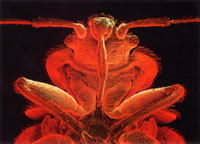|
Cimex lectularius
Traumatic
insemination: the act of inseminating through the body wall, into the
body cavity (rather than into the female’s genital tract); invoslves
physical breaching of the epidermis (Siva-Jothy 2006).
 ...these guys are gross.
...these guys are gross.
|
